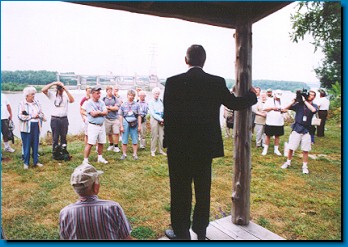 |
 Indiana
Congressman Baron P. Hill speaks to meeting participants from the steps
of a log cabin at Clark's Point, near the Falls of the Ohio on the
Indiana side of the river. General George Rogers Clark lived at this
location until 1809. A replica of his cabin sits on this spot
today. Indiana
Congressman Baron P. Hill speaks to meeting participants from the steps
of a log cabin at Clark's Point, near the Falls of the Ohio on the
Indiana side of the river. General George Rogers Clark lived at this
location until 1809. A replica of his cabin sits on this spot
today.
|
 The
Falls of the Ohio interpretive center at Clarksville, Indiana, provides
an interesting overview of the geological significance of the fossil
beds which make up the falls. Their collections include several dozen
dinosaur eggs. The
Falls of the Ohio interpretive center at Clarksville, Indiana, provides
an interesting overview of the geological significance of the fossil
beds which make up the falls. Their collections include several dozen
dinosaur eggs.
|
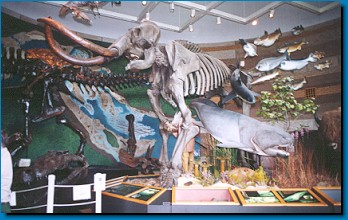 |
|
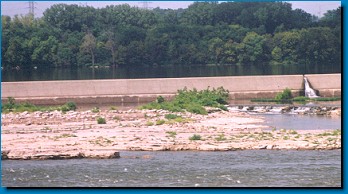
|
 Navigation of
the Ohio River is much less treacherous than it was in the 18th early
19th centuries, thanks to a dam across the river. The rocky rapids of
the Falls are under several feet of water, and fossils beds (seen in the
foreground here) with rare Devonian era remains are visible only when
the river level drops, as it often does in late
summer. Navigation of
the Ohio River is much less treacherous than it was in the 18th early
19th centuries, thanks to a dam across the river. The rocky rapids of
the Falls are under several feet of water, and fossils beds (seen in the
foreground here) with rare Devonian era remains are visible only when
the river level drops, as it often does in late
summer.
|
Martha and Molly, with reenactors
at General George Rogers Clark's cabin on Clark's Point near present-day
Clarksville, Indiana.
General George Rogers Clark's cabin on Clark's Point near present-day
Clarksville, Indiana.
Explorers Lewis and Clark first joined
forces at this point and traveled together downriver, launching the
keelboat from the mouth of Mill Creek, a few hundred yards from this
site on the north side of the river. |
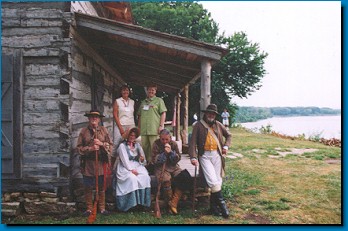
|
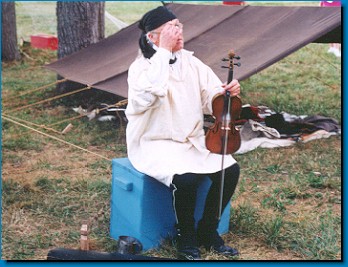 |
 "Pierre
Cruzatte" adjusts his glasses as he speaks with meeting participants
about the role of the riverman and fiddler in the Expedition's success.
Cruzatte's music added a festive quality to the holidays the men
celebrated while they were on their journey west, but his poor eyesight
nearly cost the Expedition the life of one of their leaders when
Cruzatte mistook Lewis for an elk while both men were hunting in tall
grass. "Pierre
Cruzatte" adjusts his glasses as he speaks with meeting participants
about the role of the riverman and fiddler in the Expedition's success.
Cruzatte's music added a festive quality to the holidays the men
celebrated while they were on their journey west, but his poor eyesight
nearly cost the Expedition the life of one of their leaders when
Cruzatte mistook Lewis for an elk while both men were hunting in tall
grass.
|
 A
encampment similar to what the Corps of Discovery would have had during
their journey west. The enlisted men's tents (dark olive oilcloth draped
over a ridgepole) were devised by Capt. Lewis. They did not offer much
shelter from the elements and were described by one of the reenactors as
"not one of the Captain's best ideas." The enclosed tent (light-colored
tent on the right of this photo) was the shelter used by the
Expedition's leaders, Capts. Lewis and Clark. A
encampment similar to what the Corps of Discovery would have had during
their journey west. The enlisted men's tents (dark olive oilcloth draped
over a ridgepole) were devised by Capt. Lewis. They did not offer much
shelter from the elements and were described by one of the reenactors as
"not one of the Captain's best ideas." The enclosed tent (light-colored
tent on the right of this photo) was the shelter used by the
Expedition's leaders, Capts. Lewis and Clark.
|
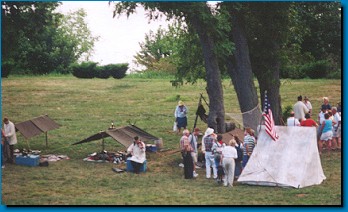
|





